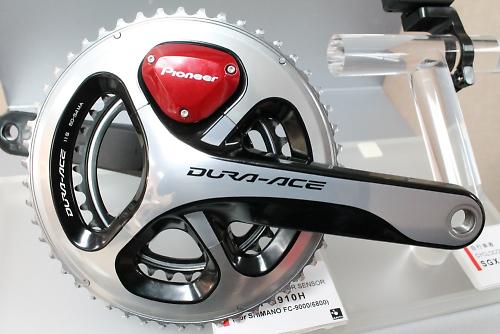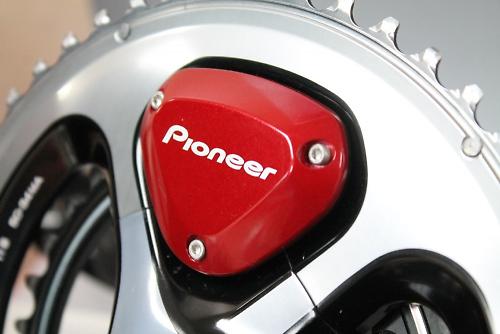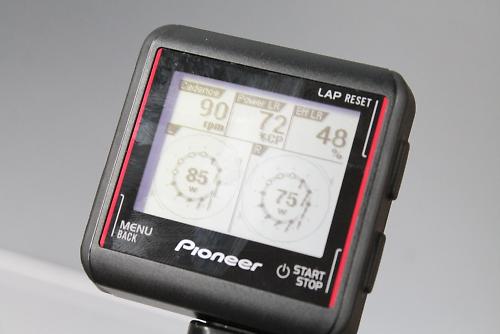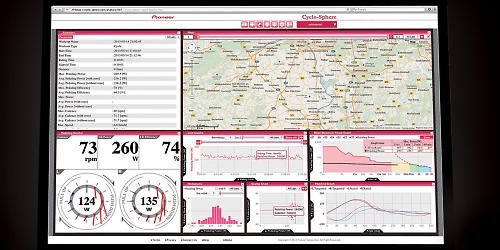- News
- Reviews
- Bikes
- Accessories
- Accessories - misc
- Computer mounts
- Bags
- Bar ends
- Bike bags & cases
- Bottle cages
- Bottles
- Cameras
- Car racks
- Child seats
- Computers
- Glasses
- GPS units
- Helmets
- Lights - front
- Lights - rear
- Lights - sets
- Locks
- Mirrors
- Mudguards
- Racks
- Pumps & CO2 inflators
- Puncture kits
- Reflectives
- Smart watches
- Stands and racks
- Trailers
- Clothing
- Components
- Bar tape & grips
- Bottom brackets
- Brake & gear cables
- Brake & STI levers
- Brake pads & spares
- Brakes
- Cassettes & freewheels
- Chains
- Chainsets & chainrings
- Derailleurs - front
- Derailleurs - rear
- Forks
- Gear levers & shifters
- Groupsets
- Handlebars & extensions
- Headsets
- Hubs
- Inner tubes
- Pedals
- Quick releases & skewers
- Saddles
- Seatposts
- Stems
- Wheels
- Tyres
- Health, fitness and nutrition
- Tools and workshop
- Miscellaneous
- Buyers Guides
- Features
- Forum
- Recommends
- Podcast
TECH NEWS
Pioneer power meter to launch mid-March
Pioneer’s power meter, which we first spotted being tested on the former Team Blanco Giant race bikes early last year, is set to come to market this month, and will cost from $1,550 - but no UK price has been confirmed yet.

Pioneer describe getting into the cycling business as “part of its activities towards opening up new horizons for innovation in people's lives and culture.”
It's a quote that suggests there is more to come. It also seems there's a fair few keen cyclists working at Pioneer.
“Our engineers, who are avid riders themselves, set out to take power measurement well beyond today’s norm,” says David Bales, manager of new business for Pioneer Electronics.

The power meter offers left and right pedalling power analysis, measuring torque and force angle at 12 different points of rotation. The design incorporates three torque sensors in each crank arm, and captures data at every 30 degrees of rotation. This offers the potential to analyse where in the crank rotation you’re applying the most power, and hone your pedalling technique as a result.
“Output analysis of both legs and understanding where and how power is applied will help riders elevate their game,” says David Bales.

The early samples we saw used zip ties to fix the various components to the cranks. They’ve since cleaned up the design and it looks tidy and seamless. The power meter is only available as a complete crankset with a choice of Dura-Ace $1,850 or Ultegra 6800, $1,550. There’s a full choice of crank arm lengths and chainring configurations. There's no word on other brand cranks being available anytime in the future.
The power meter adds a claimed 66g to the weight to the chainset. Battery power is provided by two CR2032 coin cell batteries (available all over the place) and is claimed to be good for 120 hours of riding. They’re easily replaced when they run flat. The power meter is also IPX6 and IPX7 water resistance certified. Pioneer claims an accuracy of +/- 2%, which is similar to the claims made by the likes of Stages and Garmin (Stages say that figure relates to 100W and 90rpm, and it's more accurate, in percentage terms, at higher powers).

Pioneer have also developed their own computer, XGX-CA5000, which is able to display the power output from each leg, as well as overall pedalling efficiency, power loss and force angle. The system uses the common ANT+ wireless protocol, so it should be compatible with Garmin and other devices. It also has built-in GPS so it can record routes as well as power and speed. The computer will cost $300.

It has a 1.87in black and white LCD touchscreen display, weighs a claimed 75g and features six programmable screens. As well as the information already mentioned, it can give you torque, cadence, heart rate, GPS positioning, speed, distance, elevation gain/loss, barometric pressure, ambient temperature and more. The screen can show a maximum of nine data points at the same time.
The XGX-CA5000 computer boasts Wi-Fi so you can easily upload rides to your computer, which saves you removing it from your bike and plugging it in via a USB cable.
The computer has 4Gb of memory for storing ride data and it can handle six bike profiles, should you have more than one bike with a Pioneer power meter fitted (well, you might!). Like the power meter, the computer has been certified for IPX6 and IPX7 standards. The battery is claimed to be good for 12 hours, and is charged via micro USB. It comes with a bar mount while a time trial mount is also available.

Pioneer have also developed Cyclo-Sphere, a free online service for analysing data from the power meter. You can see a live demonstration of the website.
We’ve seen the choice of power meters explode in recent years. For a long time the choice was largely between the fairly affordable Saris PowerTap and the expensive SRM Power Meter. Now the choice is more plentiful with the Garmin Vector, Stages, Power2max and a few more already on the scene and others, including the Xpedo pedal-based system, on the way.
More info at www.powerisking.com
David worked on the road.cc tech team from 2012-2020. Previously he was editor of Bikemagic.com and before that staff writer at RCUK. He's a seasoned cyclist of all disciplines, from road to mountain biking, touring to cyclo-cross, he only wishes he had time to ride them all. He's mildly competitive, though he'll never admit it, and is a frequent road racer but is too lazy to do really well. He currently resides in the Cotswolds, and you can now find him over on his own YouTube channel David Arthur - Just Ride Bikes.
Latest Comments
- dubwise 9 sec ago
Um, did the European Championships actually happen? Can't see any report on road.cc
- Hirsute 13 min 33 sec ago
Far too many in that article unable to reverse onto the driveway. Does no one know the highway code ?
- Car Delenda Est 1 hour 4 min ago
A more appropriate punishment:...
- Rendel Harris 1 hour 8 min ago
By no means claiming that Armstrong was the only doper in that period but your claim makes no sense: the average speed is taken on the time of the...
- Russell Gray 1 hour 26 min ago
Close passing and rank bad driving have almost become the norm, to the point where I expect it and it doesn't shock me. What does shock me are the...
- kingleo 1 hour 32 min ago
So why did they not make the bridge wider, one side for cyclists and the other for pedestrians with a partition in between?
- wtjs 1 hour 37 min ago
I suffered a close pass by a BMW driver 2 or 3 years ago. 10 yards later he was stopped by temporary lights. It's all on video: there's no swearing...
- ManicDrummer 2 hours 27 min ago
Electromagnetic pedals you say? Call the witch finder general!
- slc 2 hours 44 min ago
I lived in Swansea before and after the new tracks were installed, and cycled along the Mayals Rd a couple of times each week. I'm sorry to say...
- OldRidgeback 2 hours 44 min ago
Ok, so now the trial has proven successful and useful it should be introduced on a compulsory basis for all driving instructors surely?
























Add new comment
19 comments
SRM are still arguably the Gold Standard of power measurement, and will continue pricing their product as such for as long as it's economically viable. And there's nothing wrong with that, we would all do the same if our names were Mr/s SRM, wouldn't we?
They do, their power metres as a standalone product are still at the top of the scale in price.
Price-regardless SRM are at the very peak of the game at the moment, some of the work they're doing is fascinating. (for power metre nerds)
The instrumentation isn't cheap at all, we use similar kit for different applications in work and it's in the region from £750+ in our application.
Industrial uses have a much bigger market too, it's a very small amount if customers in cycling.
Also what's the crime with making a profit?
SRM etc are a business, not a charity...
Thats interesting, thanks.
I do not think there is a crime in making a profit.
My hypothesis was that perhaps they could produce and sell many more units at a lower unit cost and at a lower profit per unit, but still make a decent profit overall.
Cheers
Also some these technologies are still pretty experimental and included in the cost is a bit of danger money, to cover potential warranty claims. It's the price of being an early adopter, I'm afraid, but that's life.
I just don't get the price of power meters. They can't cost that much to manufacture and R&D must be reasonable by now as they have been available for some time.
If they halved the price, I bet they would sell more than twice as many.
Does anyone have figures on the actual margins they put on these?
Well you can do it cheaper.
Small, light, accurate, cheap. You can have 3 out of 4.
I understand your point, but what I suspect is that companies are making large margins on these power meters. So I actually would extend your list: Small, light, accurate, cheap, huge margins. ... you can have 4 out of 5
Of course, I don't know what the actual manufacturing costs and R&D investment are, so I would be interested to hear if anyone has any insight into this ...
Hmmm, I suppose they have to calibrate every meter they produce, which could add to the cost?
Cheers
It depends on the technology actually used. There's a lot of difference between methods between manufacturers.
While you have simpler, less accurate or more minimalistic technologies used in the likes of Stages and CycleOps hubs which cost anything from £300 to £900 (the cheaper range) - heading upwards to the likes of Rotor and SRM costing you upwards of £1.5-£2k because more process has gone in to developing a more complex technology.
While there's always going to be a markup and profit margin, the prices are not completely made up. A hell of a lot of r&d goes into these products, and scientists aren't cheap.
Halving the price to sell twice as many doesn't quite work, it's like real estate - if an area becomes more sought after, it doesn't drive the prices down.
Stages etc don't offer a computer as well. SRM make a head unit as well.
It depends on the technology actually used. There's a lot of difference between methods between manufacturers.
While you have simpler, less accurate or more minimalistic technologies used in the likes of Stages and CycleOps hubs which cost anything from £300 to £900 (the cheaper range) - heading upwards to the likes of Rotor and SRM costing you upwards of £1.5-£2k because more process has gone in to developing a more complex technology.
While there's always going to be a markup and profit margin, the prices are not completely made up. A hell of a lot of r&d goes into these products, and scientists aren't cheap.
Halving the price to sell twice as many doesn't quite work, it's like real estate - if an area becomes more sought after, it doesn't drive the prices down.
Cyclists seem to be the most cynical people when it comes to products.
The general view seems to be if they can't afford it or need it then it must be too expensive or a con, and heaven forbid a company is allowed to make a profit.
Don't like it, then don't buy it or take up a cheaper pastime
'lol, more stuff people don't need.'
like...a bike? not many people *need* one.
Tbh it's mad, who's going to spend this much? It's more than most road bikes cost!
The people who don't want to pay £2-3000 for an SRM system?
Considering you can go on a BMW forum and people will congratulate you for speccing the £1200 sound system, the attitude cyclists can take is baffling in comparison.
Well Said Nick T.
Power meters are not required for most casual cyclists but if someone wants to use one and can find the means to pay - why not. I'd be interested to know what my power was.
The more players in the power meter game will bring the price down.
.....anyone who trains from power?!
Which is plenty of us. Granted it's an expensive technology, and often still experimental. I see no problem with the pricing, for people who are serious about what they're doing in racing 1.5k is trivial in comparison to the unlimited benefits of having accurate power analysis. You don't *have* to spend this money.
TBH I'd be more unforgiving of the pricing on mid range carbon manufacturers, pricing keen cyclists out of the market by simply painting a name on a frame.
lol, more stuff people don't need.
Notice how all these opportune profiteering is going on but nobody and i mean nobody is doing nothing to help cycling at the level it is needed?
$1500 for this? gimme a break.
Inclusion of wifi in the computer is cool but honestly it fits into a pretty crowded price point at $1,500 to 1,800. Come on $500 power meters!!!!